Do you have a question about the Mercury 75 OptiMax and is the answer not in the manual?
Warning about chemicals in engine exhaust known to cause cancer.
Details the limited warranty coverage for the purchased product.
Details on Mercury's rating system for dealer service performance.
Compliance statement for OptiMax engines with EU directives.
Lists engine families and identification numbers for conformity.
Details on essential requirements for exhaust emissions compliance.
Details on essential requirements for noise emissions compliance.
Procedures for transferring the limited warranty to a new owner.
Steps for registering your product for warranty coverage.
Explains what services and damages are covered under warranty.
Outlines the operator's duties for safe boat and public operation.
Guide to reading the manual and understanding safe operation.
Warning about exceeding the boat's maximum horsepower rating.
Guidance on choosing the correct propeller for optimal performance.
Explains the function and importance of the engine kill switch.
Precautions for operating in shallow water or areas with underwater obstacles.
Instructions for safely trailering the boat and outboard.
Guidance on selecting the correct type and octane of gasoline.
Specifies the correct type of oil for the engine.
Overview of the functions and operations of the remote control.
Explains the horn signals and what they indicate.
How to adjust the outboard's position for optimal performance.
A list of checks to perform before starting the engine.
Steps for properly breaking in the new engine for optimal life.
Instructions on how to start the outboard engine safely.
Schedule of regular inspections and maintenance tasks.
Information and procedures related to the fuel system.
How to replace fuses to maintain electrical system integrity.
Explanation of anodes and their role in corrosion prevention.
Procedures to protect the outboard during storage.
How to prepare the fuel system for storage, including stabilizer.
Identifies causes and solutions for engine starting issues.
Discusses causes and fixes for erratic operation or performance loss.
Causes and solutions for the battery not holding a charge.
Guidance on using authorized local dealers for service.
Contact information for Mercury Marine service centers worldwide.
Crucial advice and warnings regarding outboard installation.
Warning about matching engine to boat's horsepower rating.
Guide for selecting the correct mounting height for optimal performance.
Steps for securely mounting the outboard to the boat's transom.
Procedures for transferring the limited warranty to a new owner.
Steps for registering your product for warranty coverage.
Details the limited warranty for Optimax outboards in various regions.
Specifies what defects in material and workmanship are covered.
Steps a customer must follow to obtain warranty service.
Lists items and conditions not covered by the limited warranty.
Disclaimers on implied warranties and limitations on damages.
Details the limited warranty specifically for corrosion damage.
Specifies what corrosion-related failures are covered.
Lists exclusions for the corrosion warranty.
Outlines the operator's duties for safe boat and public operation.
Guide to reading the manual and understanding safe operation.
Explains the meaning of DANGER, WARNING, CAUTION, and NOTICE symbols.
Warning about exceeding the boat's maximum horsepower rating.
Recommendations for operating high-speed or high-performance boats.
Steps and considerations for selecting the right propeller.
Explains the function and importance of the engine kill switch.
Safety precautions when people are in or near the water.
Hazards associated with jumping waves or wakes.
Information on exhaust emissions and carbon monoxide poisoning.
How to ensure proper ventilation to prevent CO accumulation.
Guidance on selecting and installing compatible accessories.
Recommendations for safe boating practices.
Importance of following nautical rules and boating safety courses.
Ensuring all passengers are seated safely and securely.
Requirements for reporting boating accidents to authorities.
Technical specifications for different engine models.
Diagram identifying key external components of the outboard.
Guidance on selecting the correct type and octane of gasoline.
Adverse effects of alcohol in gasoline on fuel systems.
EPA requirement for fuel hose material in the US.
Step-by-step guide to filling the engine's oil injection system.
Overview of the functions and operations of the remote control.
Explains the horn signals and what they indicate.
How to adjust the outboard's position for optimal performance.
How to adjust the trim tab to reduce steering torque.
A list of checks to perform before starting the engine.
Procedures for operating or storing the outboard in freezing conditions.
Recommendations for flushing and cleaning after use in saltwater.
Steps for properly breaking in the new engine for optimal life.
Instructions on how to start the outboard engine safely.
Procedures for shifting between forward, neutral, and reverse.
Importance of upkeep and recommendation for genuine parts.
Explanation of the emission certification label and owner responsibility.
Schedule of regular inspections and maintenance tasks.
Procedure for flushing the cooling system with fresh water.
Steps for removing and reinstalling the top engine cowl.
How to inspect and replace spark plugs.
When and how to replace the air intake filter.
How to inspect the alternator belt for wear or damage.
Locations and types of lubricants for various engine parts.
Checking for water in lubricant and examining drained lubricant.
Procedures to protect the outboard during storage.
How to prepare the fuel system for storage, including stabilizer.
Steps to protect internal engine parts during storage.
Instructions for storing and recharging the battery.
Identifies causes and solutions for engine starting issues.
Discusses causes and fixes for erratic operation or performance loss.
Causes and solutions for the battery not holding a charge.
Guidance on obtaining help from dealers and service offices.
Crucial advice and warnings regarding outboard installation.
Warning about matching engine to boat's horsepower rating.
Warning about starting the engine in gear.
Guidance on selecting and installing compatible accessories.
Considerations for fuel tank and hose installation.
Transom opening dimensions for single and dual engine installations.
Safety warnings and procedures for lifting the outboard.
Instructions for installing the steering cable.
How to correctly connect battery cables for a single outboard.
Connecting battery cables for dual outboard setups.
Connecting the SmartCraft wiring harness to the engine.
Connecting the water pressure tube for a gauge.
How to connect the remote fuel hose to the engine fitting.
Installing and adjusting the shift cable for proper gear engagement.
Installing and adjusting the throttle cable.
Filling the oil tank with the specified oil for the injection system.
Priming the oil injection pump to remove air before first start.
Warning about excessive trim and installing the trim limit pin.
| Engine Type | 2-stroke |
|---|---|
| Displacement | 1526 cc |
| Horsepower | 75 hp |
| Alternator | 60 amp / 756 watt |
| Cylinders | 3 |
| Starting | Electric |
| Full Throttle RPM Range | 5000-5750 rpm |
| Steering | Remote |
| Fuel Induction System | 2-stage direct fuel injection |
| Shaft Length | 20" |
| Weight | 170 kg |
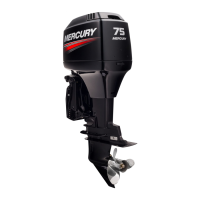
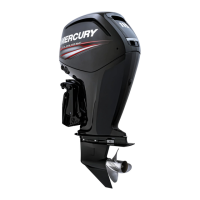
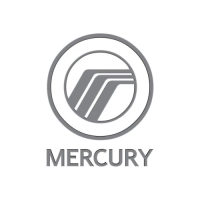

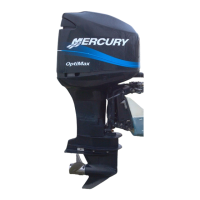
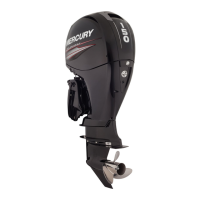
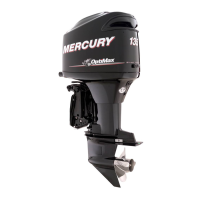
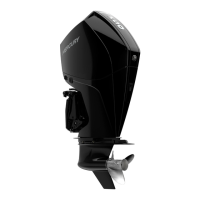
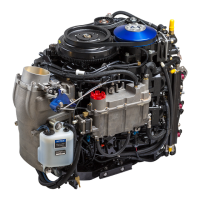
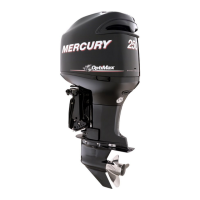

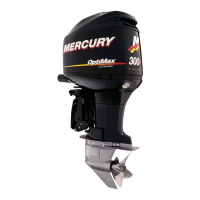
